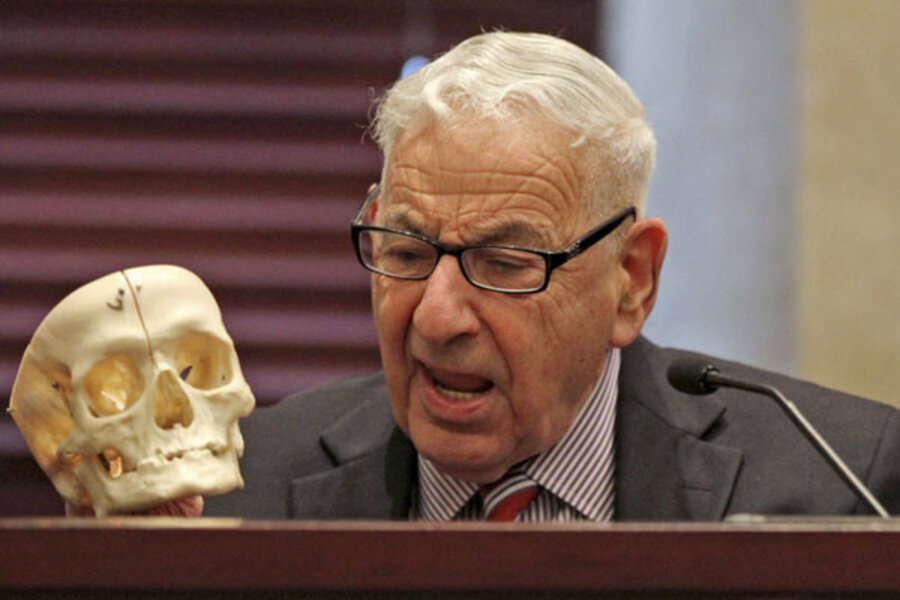Casey Anthony trial: Witness refutes duct tape as murder weapon
Loading...
A world-renowned forensic pathologist testified on Saturday at the Casey Anthony murder trial that duct tape found near the remains of Ms. Anthony’s 2-year-old daughter was not affixed to her face until after the child was already dead.
“I think the duct tape was a later event, not an early event,” Dr. Werner Spitz told the jury. He added that it was introduced “after decomposition.”
The testimony is significant because it is in direct opposition to the prosecution’s theory that Anthony killed her daughter, Caylee, by smothering her with pieces of duct tape pressed firmly over the toddler’s nose and mouth.
It also clashes with the findings of Orange County Medical Examiner Dr. Jan Garavaglia, who ruled Caylee’s death a homicide and concluded that the duct tape had been affixed to her face before her death.
His testimony came on Day 22 of Anthony’s trial in an Orlando, Fla., courtroom. She is charged with first-degree murder and faces a death sentence if convicted.
Dr. Spitz has been involved in some of the country’s highest-profile death investigations, including the assassination of President John F. Kennedy, the assassination of Martin Luther King Jr., and the O.J. Simpson murder trial.
Spitz said he concluded that the duct tape was applied after decomposition because investigators found no DNA evidence, such as pieces of skin, on what had been the sticky side of the tape. He said skin would be expected if the tape was pressed firmly onto a living person’s face.
“It is my opinion that the duct tape was stuck on there after the skin deteriorated, after the skin decomposed,” he said during cross-examination.
“How did this person put duct tape on the skull,” asked prosecutor Jeffrey Ashton in a disbelieving and dismissive tone of voice.
Spitz responded with his own sarcasm. “They took a piece of duct tape in a roll – it comes in a roll – and tore off a number of sections, maybe this long, and stuck them on the skull,” Spitz said. He said it may have been done to hold the lower jaw in place and to keep the skull intact.
Spitz also accused the medical examiner in the Anthony case, Dr. Garavaglia, of conducting a “shoddy autopsy” on Caylee’s remains. He said he was shocked to discover that Garavaglia had neglected to examine the interior of the toddler’s skull.
“The skull, the head, is part of the body, and when you do an autopsy you examine the whole body,” he said.
Mr. Ashton asked Spitz whether there is a written protocol requiring medical examiners to inspect the interior of a skull. “Where is this protocol published?” he asked.
The pathologist, who said he’d assisted or conducted 60,000 autopsies during his 56-year career, said examination of the skull is routine practice among medical examiners.
“That tells me about a shoddy autopsy,” Spitz said. “Excuse me for the term, but you provoked it,” he said to Ashton.
“I didn’t mean to provoke you,” Ashton replied.
“It upsets my better understanding of my profession that someone would do an autopsy and not examine the head,” Spitz said.
Spitz said an examination of the interior of the skull revealed how the head was positioned as it decomposed. He also said a discoloration of interior skull bones, if observed, could reveal evidence that the individual had died of suffocation.
Suffocation is the prosecution’s theory of how Caylee died. Spitz said his examination of the skull showed no evidence of suffocation.
Spitz testified that he also disagreed with Garavaglia’s conclusion that Caylee’s death could be classified as a homicide. He said there was not enough information to render a scientific opinion on the manner of death.
Suicide could be ruled out, he said. But he could not rule out the possibility of natural causes, homicide, or an accident.
Also on Saturday, Judge Bevin Perry threatened to impose sanctions on defense attorney Jose Baez after Mr. Baez asked an earlier witness, forensic anthropologist Dr. William Rodriguez, to offer his opinion about the interaction of a decomposing body with duct tape.
The prosecution objected to the line of questioning, saying the issue had not been identified and disclosed to prosecutors in a pretrial report. Judge Perry had required both sides in the case to file reports identifying the potential testimony of all expert witnesses. The requirement is designed to prevent ambush tactics during the trial.
Baez said the witness’s testimony was intended to answer an animated video shown to the jury suggesting how the duct tape could have been placed over Caylee’s mouth and nose at the same time.
Dr. Rodriguez was prepared to testify that, under the circumstances and conditions at the wooded site where Caylee’s skeletal remains were recovered, it would be impossible to draw a “scientific conclusion as to the portion of the duct tape around the area of the eyes, nose, and mouth, or just the mouth.”
Rather than excluding the testimony, Perry ordered that the witness be questioned by both defense and prosecution lawyers Saturday afternoon away from the courtroom. Rodriguez will likely return to the stand on Monday.
Less clear is whether Perry will impose sanctions against Baez. “I will reserve the decision whether to proceed with contempt proceedings at the conclusion of this trial,” the judge said.
The trial is set to continue on Monday morning.





